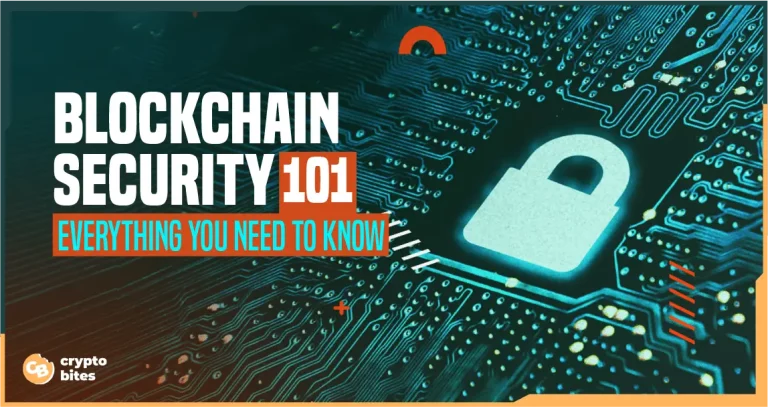
Blockchain Security 101 – Everything You Need to Know
You’ve probably heard about the buzzword blockchain security. It’s getting thrown around a lot these days. But there’s a good reason for all the hype.
Get this: the actual value of liquid assets on the blockchain is a mind-blowing $1 trillion. Yeah, trillion with a capital “T.”
Now, imagine that kind of money just hanging out there. It’s like a giant pot of gold, and you better believe there are folks out there trying to figure out how to sneak a piece of that pie.
Well, that’s exactly where blockchain security comes into play.
I’ll break it down for you and show you exactly why blockchain security is the real MVP and how it’s keeping all those digital assets safe and sound.
Let’s find out more!
What is Blockchain Security?
Blockchain security refers to the technologies, and best practices implemented to mitigate risks, thwart malicious attacks, and prevent unauthorized access within blockchain networks.
The security measures are crucial for maintaining the integrity, confidentiality, and availability of information stored on the blockchain.
Why is Blockchain Security Important? Let The Stats Speak
One of the biggest benefits of using blockchain is its ability to provide security in each transaction, thanks to its inherent technologies like cryptography, decentralization, and consensus.
This is quite evident in the fact that almost 69% of banks are using blockchain technology with the overarching goal of fortifying their operational security. Despite this, instances of cyber attacks on blockchain aren’t too rare either.
Here are a few examples of cyber attacks on blockchain by hackers:
- Decentralized Autonomous Organization (DAO) Attack
The venture capital firm DAO fell victim to a code exploitation attack, resulting in the illicit acquisition of over $60 million in Ether cryptocurrency.
- Bithumb Cryptocurrency Exchange Hack
Bithumb, a superbly renowned cryptocurrency exchange got hacked. The hackers successfully stole the data of 30,000 users, leaving them vulnerable to future attacks of different kinds. That, however, wasn’t the only thing. They also stole over 870,000 dollars worth of Bitcoin.
The events clearly show how important it is to have an advanced blockchain security foundation for organizations. Blockchains offer significant benefits, and as a result, many financial, governmental, and non-governmental organizations are adopting them.
However, this rapid adoption leaves room for cybercriminals who are waiting to exploit this vast market.
Common Threats to Blockchain Security
Blockchain is vulnerable to several cyber threats. I’m giving you a small glimpse of each of these issues:
1. Sybil Attacks
Public blockchains, allowing open participation, face the risk of Sybil attacks. Attackers flood the network with fraudulent participants, gaining control to validate fake transactions and compromise the blockchain’s integrity.
2. 51% Attacks
In 51% attacks, malicious entities collaborate to control over 50% of the mining power, enabling them to manipulate transactions and potentially engage in double-spending.
3. Routing Attacks
Blockchain networks are susceptible to routing attacks, where attackers manipulate configurations to intercept and manipulate unencrypted communication between nodes, compromising data integrity
4. Phishing Attacks
Social engineering techniques in phishing attacks aim to trick participants into revealing sensitive information, such as private keys and passphrases, leading to unauthorized access and control.
5. Double Spending
Double spending poses a threat to blockchain applications when an individual attempts to spend the same cryptocurrency simultaneously at different locations, necessitating robust mechanisms to ensure transaction integrity.
6. Smart Contract Vulnerabilities
Smart contracts, while powerful, introduce unique vulnerabilities. Flaws in the code can lead to exploits, allowing attackers to manipulate transactions and compromise blockchain integrity.
7. Denial-of-Service Attacks
Denial-of-service attacks disrupt blockchain functionality by overwhelming the network with queries, causing transaction delays or temporary unavailability.
Best Security Practices to Protect Blockchain Networks
Despite the cyber attacks and vulnerabilities, blockchain can be protected using tons of different security measures. Below I’m showing 5 best security practices that you can use to fortify the integrity and resilience of blockchain networks:
1. Appropriate Blockchain Selection
Ensure that the chosen blockchain technology aligns with the type of transactions it will be recording. If dealing with personal or sensitive information, evaluate the blockchain’s privacy features to prevent inadvertent data exposure. Assess whether transactions are genuinely immutable or if there’s a need for flexibility in altering or removing earlier transactions.
2. Adherence to Cybersecurity and Privacy Standards
Treat blockchain networks like any other software in terms of cybersecurity and privacy. Follow relevant laws, regulations, and standards throughout the lifecycle of the blockchain, ensuring that security measures are continuously updated to address evolving threats.
3. Strong Identity Management
Implement strong identity management practices to verify the legitimacy of participants, even in public blockchain networks. For private blockchains, emphasize access management to prevent unauthorized access, safeguarding against potential attackers attempting to compromise network integrity.
4. Regular Risk Assessments and Audits
Conduct frequent risk assessments and audits of the blockchain technology and associated processes, such as key management. Identify and address vulnerabilities promptly. Regular assessments ensure that security measures remain effective and up-to-date, adapting to emerging threats in the rapidly evolving blockchain landscape.
5. Preparedness for Security Incidents
Anticipate potential security incidents and establish well-defined response and recovery procedures. Be prepared for scenarios such as the discovery of new vulnerabilities, private key theft, or the compromise of participants’ computers. A robust incident response plan minimizes downtime and potential damage in case of a security breach.
6. Conflict Resolution Mechanisms
Acknowledge the possibility of disputes among blockchain network participants and establish mechanisms for effective conflict resolution. Proactively manage disagreements to prevent interruptions in the functioning of the blockchain. Clear governance structures and dispute resolution processes contribute to the stability and reliability of the network.
7. Encryption and Secure Communication
Prioritize end-to-end encryption for communication within the blockchain network. This prevents unauthorized access and eavesdropping on sensitive information. Secure communication channels strengthen the overall integrity of the blockchain and protect against potential attacks targeting data in transit.
8. Multi-Signature Wallets
Utilize multi-signature wallets to enhance security, requiring multiple private keys to authorize transactions. This adds an extra layer of protection against single points of failure, reducing the risk of unauthorized access or fraudulent transactions.
9. Continuous Education and Training
Keep all stakeholders, including developers, administrators, and users, well-informed about the latest security threats and best practices. Regular training sessions ensure that everyone involved in the blockchain network is aware of security protocols and can contribute to its overall safety.
10. Secure Smart Contract Development
Ensure secure coding practices to mitigate smart contract vulnerabilities. Smart contracts should undergo rigorous testing, code reviews, and audits to identify and address potential security flaws before deployment.
Different Types of Blockchain Security
The security system of blockchain can differ based on its’ types. Here is a brief overview of blockchain security types:
1. Public Blockchain (Permissionless Blockchain)
In a public blockchain, participants can engage without restrictions on access or block publishing, allowing for anonymity. The security challenges involve safeguarding against Sybil attacks, where malicious actors create multiple fake identities, and 51% attacks, where a single entity gains majority control, risking the integrity of the blockchain.
2. Private Blockchain (Permissioned Blockchain)
Private blockchains enforce restrictions on block publishing and access, requiring user identification and authentication. Security measures focus on preventing unauthorized access, addressing potential insider threats, and securing the consensus mechanism, which involves a limited number of nodes controlling the blockchain.
3. Hybrid Blockchain
Hybrid blockchains combine public and private components, forming an interoperable system. Security considerations include ensuring seamless interoperability, addressing challenges in consensus mechanisms that span both segments, and maintaining data privacy on private blockchains while interacting securely with the public counterpart. Customized security measures are crucial for the unique characteristics of hybrid blockchains.
To Sum it All Up
Blockchain no doubt is a technology that will continue to flourish in the days ahead. But I’ve seen a lot of entrepreneurs and tech enthusiasts rushing it. I personally feel it would be much better to first build up a security infrastructure and before moving to blockchain technology. When secured, blockchain’s defense is pretty much impenetrable.




